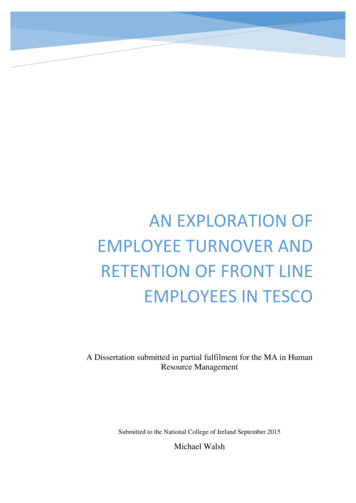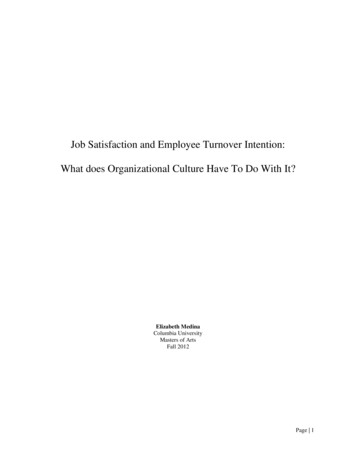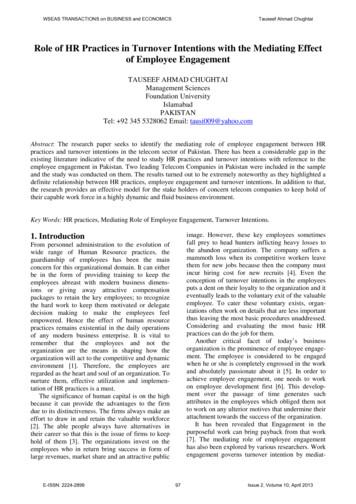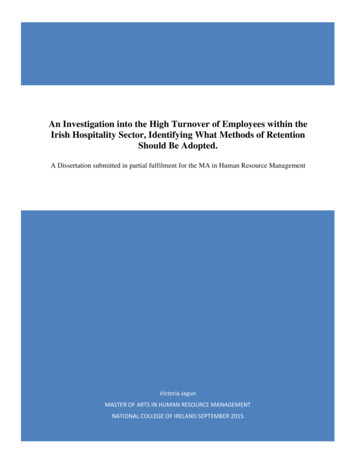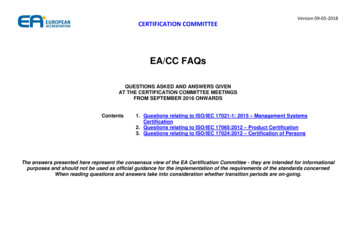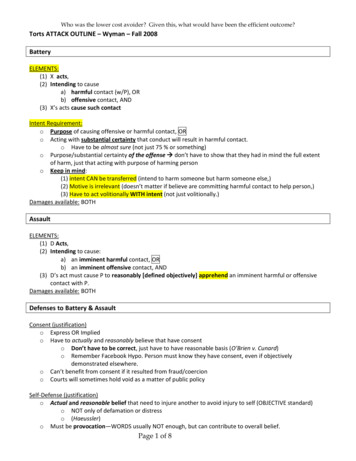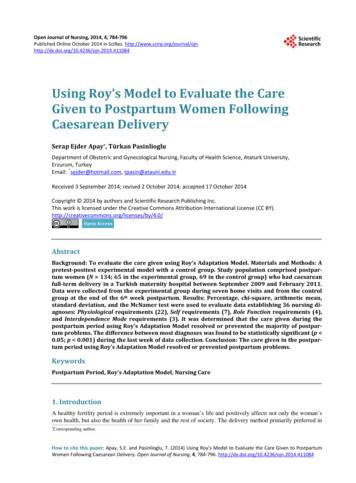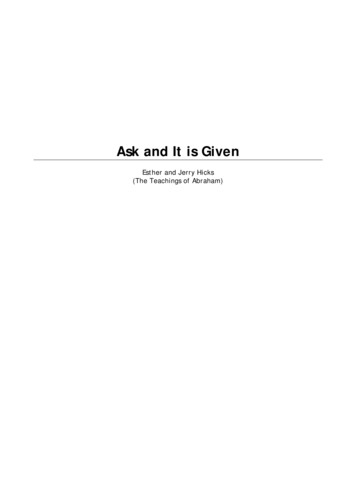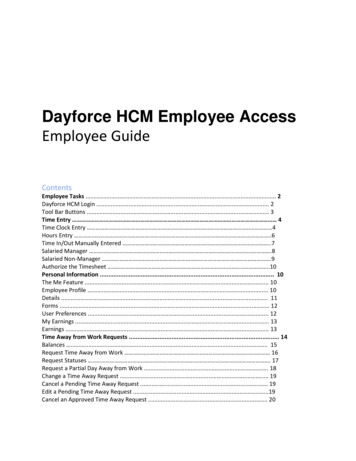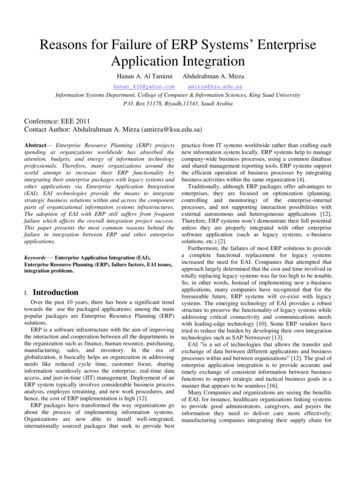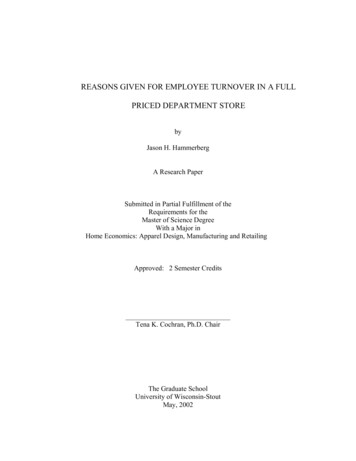
Transcription
REASONS GIVEN FOR EMPLOYEE TURNOVER IN A FULLPRICED DEPARTMENT STOREbyJason H. HammerbergA Research PaperSubmitted in Partial Fulfillment of theRequirements for theMaster of Science DegreeWith a Major inHome Economics: Apparel Design, Manufacturing and RetailingApproved: 2 Semester CreditsTena K. Cochran, Ph.D. ChairThe Graduate SchoolUniversity of Wisconsin-StoutMay, 2002
The Graduate SchoolUniversity of Wisconsin-StoutMenomonie, WI 54751ABSTRACTHammerberg, Jason H.Reasons Given for Employee Turnover in a Full Priced Department StoreM.S. Home EconomicsDr. Tena Cochran5/200265ppPublication Manual of the American Psychological Association (4th ed)Employee turnover in the retail workplace has become an important area ofresearch from both a theoretical and a practical standpoint. It is important from atheoretical perspective, in understanding how the underlying causes of turnover canprovide insights into how to control the growing problem and where a retailer's specificturnover problems lie. However, from a practical standpoint, learning how to minimizethe turnover of skilled employees is crucial from the business expense side. Retailers inthe twenty-first century must be able to keep knowledgeable and experienced employeesworking in their organization. This problem is even more critical in today's retail worldconsidering unemployment rates are hovering near a 30-year low.This study examined 1190 employee exit interviews from a chain of fifty-threedepartment stores to analyze the reasons given for leaving the organization.The 41 different reasons for leaving the organization were organized into categoriesbased on similarities found. Significant differences were found in the reasons given fortermination based on employment status and length of employment.
Full time and part time employees most often left due to job-related reasons.Hourly employees most often left due to non-job related reasons. Exiting employees whohad worked in the department store three months or less most frequently left withoutnotice (27.8%), while exiting employees who had worked 12 months or more mostfrequently left due to job-related reasons. No significant differences were found in thereasons given for termination by males and females. The findings of this research can beused in the development of appropriate programs to reduce the level of employeeturnover within retail organizations.
ACKNOWLEDGEMENTSI would like to thank my family for contributing to my life as a whole and supporting mydecisions along the way. I would especially like to thank my father who always pushedme to get a college education. His constant reminders of college have been in my mindsince I was a child. His pursuit of a Masters degree was a great influence in my life andhas shown through in the completion of my Masters degree.I would also like to thank Dr. Tena Cochran. She has been spent several hours and muchof her personal time for the completion of my research paper. Without her knowledge andexpertise this paper would not have been accomplished.
TABLE OF CONTENTSAbstract. .iiAcknowledgements.ivTable of Contents. .vList of Tables.viChapter 1: Introduction. .1Chapter 2: Review of Related Literature. . .7Chapter 3: Methodology. . 40Chapter 4: Results . .43Chapter 5: Summary, Conclusions and Recommendations. 58References. .63
LIST OF TABLESTable 1: Type of Information Provided by Exiting Employees. . .44Table 2: Exiting Employees by Gender. . . 45Table 3: Total Termination by Employee Status. . .46Table 4: Frequency and Percentage Distribution of Exiting Employee byLength of Employment. . 47Table 5: Number of Exiting Employees by Store Location . 47Table 6: Frequency and Percentage of Reasons for Termination by ExitingEmployees. .49Table 7: Frequency and Percentage of Reasons for Termination byGender. . .50Table 8: Frequencies and Percentages of Reasons for Termination byEmployment Status. . .52Table 9: Collapsed Categories of Individual Reasons for Termination. . .53Table 10: Frequency and Percentage Distribution of Reason for Terminationby Category. . .54Table 11: Frequency and Percentage Distribution of Reason for Terminationof Male and Female Employees by Category. . . 54Table 12: Frequency and Percentage Distribution of Reasons for Termination byEmployment Status. . . .55Table 13: Frequency and Percentage Distribution of Reason for Termination byLength of Employment . .56
-1-CHAPTER ONEINTRODUCTIONThe problem of employee turnover has been one of the most studied topics inretail history (Schwab,1991). Employee turnover continues to plague many retailersbecause there are no clear resolutions to the problem despite years of research. A greatdeal of the early research literature, especially prior to 1980, focused primarily on thecauses of turnover (Mueller & Price, 1989; Price, 1977; Staw, 1980). The findings ofthese researchers revealed some of the major causes of retail turnover and made use of avariety of definitions for employee turnover, which are delineated in the followingparagraphs.The exact definition of what constitutes employee turnover varies from oneresearch study to another. Price (1977) defines turnover as “the degree of individualmovement across the membership boundaries of a social system” (p.4). When a group ofemployees is considered a social system, this definition would apply and includesaccession and the hiring of new employees within an organization. Macy & Mirvis(1976) viewed turnover as “any departure beyond organizational boundaries” (p. 224).Although these definitions vary somewhat, each was appropriate in the context of thespecific research study in which it was used.For this study, Mobley’s (1982) definition most accurately reflects the conceptualposition of the research. Mobley stated that turnover is “the cessation of membership in
-2-an organization by an individual who received monetary compensation from theorganization” (p. 10).Given corporate America’s increased use of temporary workers, this definitioninsures that those contracted for a temporary period, often through an outside agency,would not be considered. Also excluded from consideration are those who transferwithin the same organization. A final salient feature of Mobley’s definition is theinclusion of all forms of cessation from the organization, which would most typicallyinclude an interruption such as a layoff, disability or permanent discontinuation.Previous research findings indicated that some causes of employee turnover arejob-related factors that are somewhat within the direct control of the employer. Examplesof such factors would be dissatisfaction with working conditions, supervising conflicts,scheduling conflicts or salary discrepancies. Understanding the causes of job-relatedturnover is crucial in being able to identify problems within an organization that might becontrolled by the employer. Corrective steps taken in this area included training programsfor supervisors, clarification of the employee's purpose or role and identifying schedulingsolutions (Ulschak & Snowantle, 1992).In contrast, non job-related causes of employee turnover are generally out of theemployer’s control. Non job-related causes of employee turnover are those things in theemployee's personal life that impact their performance in the workplace. Examples ofthese would be relocation, family problems and chemical abuse. Although these causesare not directly within the employer’s control, some organizations have sponsoredresponsive programs for the non job-related category such as employee assistance
-3-programs and stress management training that better prepared employees to deal withpersonal issues that impact their work performance.More recently, the retail industry has been alert to the changing needs ofemployees and has modified and expanded position offerings to address these needs(Ulschak & Snowantle, 1992). The dynamics have changed the way positions aredeveloped and will evolve over an employee’s tenure with the organization. Additionalinsight into the causes of employee turnover within an organization helps to focusattention on finding real solutions to a problem that will not disappear.Purpose of the StudyThe purpose of the study was to investigate the causes of employee turnover in achain of 53 full-price department stores located in the midwestern portion of the UnitedStates. The findings of such an investigation would be useful in refining personnelpractices and hopefully decreasing the incidence of job-related employee turnover in theorganization.Problematic employee turnover rates have continued to plague the retail industry.From a very practical standpoint, minimizing the turnover of skilled employees is crucialin reducing the escalating costs associated with replacing the exiting employees. At thisparticular time, when overall unemployment has been at or near a 30-year low, it seemsparticularly prudent to keep knowledgeable and experienced employees working in anorganization.
-4-Statement of the ProblemThis research examined the causes of employee turnover in a chain of 53 fullprice department stores located in the midwestern portion of the United States.The study utilized data extracted from the exit interview questionnaires completed by1190 exiting employees of the chain, which included the individual reasons given forleaving the organization.Objectives of the StudyThe objectives for this study were:1. To identify the type of employees who terminate employment in a chain of full pricedepartment stores located in the midwestern part of the United States.2. To identify the causes of employee turnover in a chain of 53 department storeslocated in the mid-western United States.3. To identify possible opportunities for the employer to decrease future employeeturnover within the organization.HypothesesIn order to complete this study, the following hypotheses were tested:1. There is no statistically significant difference in the reasons given for employeeturnover by full-time, part-time and hourly retail employees in the selected departmentstore chain for the period of June 1, 1999 through September 30, 1999.2. There is no statistically significant difference in the reasons given for employeeturnover by male and female retail employees in the selected department store chain forthe period of June 1, 1999, through September 30, 1999.
-5-3. There is no statistically significant difference in the reasons given for employeeturnover based on length of employment in the selected department store chain for theperiod of June 1, 1999, through September 30, 1999.Definition of TermsFor clarity and understanding throughout this study the following terms were defined.Employee Turnover. This term is used to describe the ending of a relationship betweenan organization and a person who received monetary compensation from theorganization.Job-Related Turnover. This term is used to describe employee turnover for reasons thatare within the direct control of the employer. Job-related reasons given for leaving theorganization include dissatisfaction with working conditions/environment, conflictswith supervisors, scheduling conflicts or salary discrepancies.Non Job-related Turnover. This term is used to describe employee turnover due tothings in the employee's personal life that impact the individual’s performance in theworkplace. Examples of these non job-related reasons would be relocation, familyproblems, marriage, children and chemical abuse.Organizational Fit. This term is used to describe how well an employee fits in to aparticular work environment. A poor organizational fit occurs when the personality orbeliefs of an employee contrast greatly with the company and or co-workers. This canlead to disagreements and a distressing work environment.AssumptionsIt was assumed that the exit interviews collected from the corporate human
-6-resource offices were a reliable measure of employee turnover during the period. It wasalso assumed that the responses made by exiting employees accurately reflected theirreason or reasons for leaving the organization.Limitations1. The participants in the study were limited to the 1190 exiting employees whocompleted an exit interview during the period of June 1, 1999 through September 30,1999.2. The findings of this study are limited only to this particular retail organization and donot allow generalizations to the larger population or to the retail industry as a whole.
-7-CHAPTER TWOREVIEW OF RELATED LITERATUREEmployee turnover has become an important area of research from both atheoretical and practical standpoint. It is important from a theoretical perspective, inunderstanding how the underlying causes of turnover can provide insights into how tocontrol the phenomenon. However, from a practical standpoint, learning how to minimizethe turnover of skilled employees is crucial in reducing employee replacement costs(Keaveney, 1992). Also, decreasing employee turnover keeps knowledgeable andexperienced employees working in the organization. A large portion of the employeeturnover problems that we have seen in the recent past can be directly linked to the factthat jobs were plentiful and employees were scarce, considering overall unemploymentwas at or near a 30-year low. In this chapter the researcher reviewed a variety ofpublished literature dealing with employee turnover in general and some more specific toemployee turnover in the retail industry.Turnover DefinedEmployee turnover has been one of the most studied subjects in organizationalbehavior literature (Schwab, 1991), yet continues to elude any concrete conclusions. Tobetter understand the implications of turnover, one must understand how turnover isdefined.
-8-Price (1977) defines turnover “as the degree of individual movement across themembership boundary of a social system” (p. 4). This definition includes accession andthe hiring of new employees. Macy & Mirvis (1976) succinctly state that turnover is “anydeparture beyond organizational boundaries” (p. 224).Although the literature is filled with many other definitions, Mobley’s (1982)definition most accurately reflects the conceptual position of this thesis. Mobley statesthat turnover is “the cessation of membership in an organization by an individual whoreceived monetary compensation from the organization” (p.10). Given corporateAmerica’s increased use of temporary workers, this definition insures that those who mayhave been contracted for a temporary period, often through an outside agency, will not beconsidered. Also excluded from consideration are those who transfer within theorganization. A final salient feature is Mobley’s inclusion of all forms of cessation fromthe organization.The employee turnover rate is usually calculated by dividing the number ofemployees separated from the company they were working for by the base number ofjobs during the period. Employees who transfer to other positions within the sameorganization are not considered in the calculation, as well as those who retired, had theirjob phased-out or were terminated due to downsizing.Turnover rates for employees can be measured and compared over time andacross companies using what is commonly referred to as the employee turnover index.
-9-The index is calculated as follows:TTR [S/N] x 100TTR total turnover rateS number of employees separated in the periodN average number of employees in the unit in the periodSome companies add in the number of new positions added during the year to geta more accurate turnover figure. Employee turnover that results in vacancies caused byinternal promotions are not included in most turnover statistics.Types of TurnoverThere are a few generally accepted models of employee turnover. The first modelsuggests that turnover is either voluntary or involuntary. Suggesting that an employee haschosen to leave the organization (voluntary) or they have been forced to leave(involuntary). However, Jackofsky (1984) explains that modeling turnover in this mannercan vary significantly from an employee viewpoint to that of the employer. Belowaverage performers may be forced out of an organization with threats of firing or withunattractive hours or assignments, yet if the employee initiates the terminations they arerecorded as voluntary. These types of employee initiated resignations are not truly afunction of the employees desire to leave and, therefore, should be treated separately(Jackofsky, 1984). In addition to the voluntary/involuntary model there is a second
- 10 -model that has been generally described as job-related, non-job-related, and lack of fitwithin the organization (Ulschak & Snowantle 1992).Job-related turnover includes employees who left the organization due to reasonsthat were somewhat within the control of the employer. Such factors would includedissatisfaction with working conditions, supervising conflicts or salary discrepancies.Non-job related turnover occurs when an employee leaves the organization due to thingsin the employee's personal life that impact their performance in the workplace. Examplesof these would be relocation, family problems, marital issues, emotional instability ormental health, addictions, and chemical abuse. The third type of turnover is due to theemployee’s lack of fit within the organization. Examples of this type of turnover wouldinclude employees who were so uncomfortable in the work environment that they couldnot continue the employment. The discomfort may be due to many reasons. Possiblythey are not fully qualified and they are having difficulty fulfilling the position, orperhaps the employee is qualified but does not work best in the work environment he orshe is being placed in. These are just a few examples of an employee’s lack of fit withinthe organization.Factors Leading to TurnoverControlling employee turnover can constitutes a complex and challenging task forboth the workplace and administrators. Managers may have difficulty understanding andor accepting employee turnover within their organization, due to a myopic perspective ofthe situation. However, identifying the underlying causes, quantifying the problem, and
- 11 -identifying possible solutions to high employee turnover can prove to be valuableinformation for managers who wish to make a difference (Mobley, 1982).Numerous researchers have tried to identify the various contributing factors toemployee turnover in the workplace in addition to the causes of turnover anddissatisfaction. Traditional theories have focused on how employees make their decisionto leave the workplace. Within these studies, several of the following factors havecontinued to surface in relation to turnover, showing that there are leading underlyingfactors that exist in causing the actual act of tur
The exact definition of what constitutes employee turnover varies from one research study to another. Price (1977) defines turnover as “the degree of individual movement across the membership boundaries of a social system” (p.4). When a group of employees is considered a social system,
